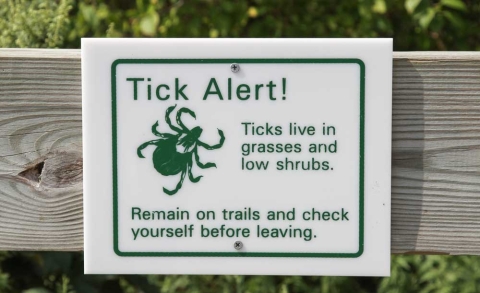Note: The Yale School of the Environment (YSE) was formerly known as the Yale School of Forestry & Environmental Studies (F&ES). News articles and events published before 1 July 2020 refer to the name of the School at that time.
As people in the northeastern US begin to return to the outdoors with the arrival of spring, they will take 1 billion fewer trips than they would if Lyme disease did not exist, a new Yale study concludes.
In an analysis published in the journal Environment and Resource Economy, researchers found that perceived risks of contracting Lyme disease cause the average person in the Northeast to forgo eight 73-minute outdoor trips per year, costing them about nine hours of outdoor time per year. Although the cost of individual missed trips is small—about $2.75 to $5—the total cost is about $2.8 to $5 billion annually because of the large number of people in the area.
“Lyme disease has been around for a few decades, but it still has a big cost to society,” he said Eli Fenichel, assistant professor at the Yale School of Forestry & Environmental Studies (F&ES) and senior author of the paper. “But the cost is not what people spend on doctors, medicine, or even bug spray. These are costs that everyone bears because we all choose second-choice activities to avoid Lyme disease.”
“A lot of people are making very small changes, but in such a densely populated area it has a significant impact.”
Lyme disease has been around for a few decades, but it still has a high cost to society. But the cost isn't what people spend on doctors, medicine, or even bug spray.
Lyme disease is caused by the bacterium Borrelia burgdorferi and is transmitted to humans through the bite of an infected blacklegged tick, according to the US Centers for Disease Control and Prevention (CDC). Common in the northeastern US and the Great Lakes region, the disease causes fever, headaches, fatigue and a skin rash. It can be prevented by using repellents and removing ticks, as well as by taking costly steps to remove tick habitat.
Or, the researchers suggest, individuals may simply find alternative activities to avoid tick habitat altogether.
To assess how Lyme disease risk affects human behavior, researchers analyzed data from the American Time Use Survey—a project based on U.S. Bureau of Labor Statistics data that provides nationally representative estimates of how , when and with whom people spend their time. and CDC data from 2003 to 2012.
After comparing these data sets, they found that the average person in the average county spent 1.54 fewer minutes outside per day in response to an average of 72.17 cases of Lyme disease reported to the CDC. This amounts to about 9.41 hours per year.
The research team says that while it is difficult to put a monetary cost on these lost opportunities, they calculate the welfare loss based on how much people are willing to spend to travel to recreate outdoors relative to free time. their time at home – the location of most indoor free time.
“People are giving up on travel, and it's not just hiking and camping in the woods,” he said. Kevin Berry, a former postdoctoral fellow at F&ES and lead author of the study. “It's trips to the park, soccer games, or walks and bike rides in places where there are trees and tall grasses … a wide variety of activities just about anywhere in this part of the Northeast that's outdoors.”
People are giving up on travel and it's not just hiking and camping in the woods. It's trips to the park, soccer games, or walks and bike rides in places where there are clumps of trees and tall grasses.
The findings demonstrate the importance of careful assessment when assessing ecosystem services and, in some cases, the 'flaws' of nature's ecosystems. Indeed, although the historical perception of forests as places to be feared has largely been replaced by the recognition that these spaces provide important services – including recreational opportunities – there are still some risks that can undermine these potential benefits, including the threat of tick-borne Lyme disease.
Lyme disease is representative of many environmental problems, Fenichel said. Environmental hazards and damages may have seemingly small effects on individuals, but they can impose serious costs on society.
“It's an issue that affects us all, but it's one of those environmental challenges that is so difficult to address as a society,” Fenichel said. “It's a big issue overall — up to $5 billion in this case — but for none of us it's not a big issue. Everyone cares a little, but maybe not enough to take action. However, overall we would be much better off if we worked together to tackle Lyme disease.”
The study was a collaboration between Fenichel and three former postdoctoral scholars at F&ES: Berry, who is now at the University of Alaska in Anchorage; Jude Bayham, who is now at California State University in Chico. and Spencer Meyersenior ecologist at the Highstead Foundation.



